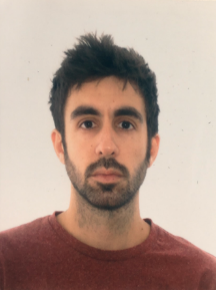
Research Lines
TRANSMAG
- Engineering magnetic and electronic phases in 2D transition metal chalcogenides.
Relevant publications
- Chesnyak; M. G. Cuxart*; D. Baranowski; K. Seufert; I. Cojocariu; M. Jugovac; V. Feyer; W. Auwärter*, 2023, Stripe-Like hBN Monolayer Template for Self-Assembly and Alignment of Pentacene Molecules, Small 2304803, 1-9. 10.1002/smll.202304803
- G. Cuxart*; K. Seufert; V. Chesnyak; et al; H. Sachdev*, W. Auwärter*, 2021, Borophenes made easy, Science Advances. 7-45, 1-8. 10.1126/sciadv.abk1490
- G. Cuxart*; M. A. Valbuena; R. Robles; et al.; S. O. Valenzuela*; A. Mugarza*, 2020, Molecular Approach for Engineering Interfacial Interactions in Magnetic/Topological Insulator Heterostructures, ACS Nano. 14-5, 6285-6294. 10.1021/acsnano.0c02498
Dr. Marc González Cuxart (Ph.D. in Physics, Autonomous University of Barcelona UAB 2019) is a surface scientist currently working at the Catalan Institute of Nanoscience and Nanotechnology (ICN2), with extended postdoctoral experience acquired through a Marie Skłodowska-Curie Individual Fellowship (MSCA-IF) at the Technical University of Munich, and a MSCA-COFUND fellowship at IMDEA Nanociencia (Madrid). His research interest lies on the creation of nanoscale model systems where quantum phenomena can be studied and manipulated with atomic precision.
MEET DR GONZÁLEZ CUXART
The goal of his project is to study magnetism at the two-dimensional limit. In particular, Dr Marc González aims to engineer long-range magnetically ordered phases in materials that belong to the family of twodimensional transition-metal chalcogenides. This topic fascinates him because it seeks fundamental understanding about magnetic phenomena occurring under confinement in two dimensions, at the same time that can provide valuable magnetic materials for the future quantum technologies.
The project is being conducted in the Nanoscale Imaging of 2D Materials group, under the supervision of Amadeo L. Vázquez de Parga. He hopes to greatly benefit from the combination of expertise of its members in transition-metal chalcogenides, and use of the state-of-the-art scanning tunnelling microscopes.
At the same time, the project requires intense of collaboration with researchers from other research programmes at the institute that master complementary experimental techniques, such as the spin-polarized ARPES or Advanced Magneto-Optics labs, and condensed-matter theoreticians from First-Principles Modelling for Quantum Materials group.
He has known IMDEA Nanociencia since years as it is a world-leading institution when it comes to scanning probe microscopies. Therefore, He used to keep an eye on the job opportunities offered by IMDEA Nanociencia, by periodically checking its homepage or social networks.
Before joining IMDEA Nanociencia, He had personal connections with some researchers of the institute working in this field, like Manuela Garnica or David Écija. They had been postdoctoral researchers at TU Münich earlier in their careers, in the same group where he just came from. This aspect, together with the prestige of the institute and the Marie Skłodowska-Curie Actions, made an easy decision.
He has benefited from career development plans in the past, also supported by the MSCA Actions. The training and support offered that he received were valuable, and he is eager to keep up with them. In addition, Dr González hopes that the secondment planned within the IDEAL Fellowship will widen his expertise and research network
More information on the IDEAL Fellowships Programme https://idealcofund-project.eu/postdoc/
The IDEAL Fellowships Programme is supported by the Marie Skłodowska-Curie Actions (MSCA) COFUND. Grant agreement ID: 101034431.
